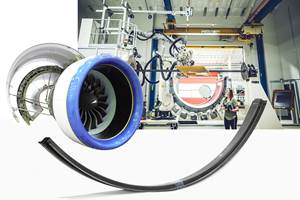What the 787 says about the future
My oldest son is 12. College for him is seven years away, but he’s already thinking about it.
My oldest son is 12. College for him is seven years away, but he’s already thinking about it. Half-jokingly, I suggested he attend the University of Wyoming, study composites materials and manufacturing and then seek a job at Adam Aircraft (we live in Colorado). The future, I said, is bright. This got me to thinking, though: When he finishes college, where in their evolution will aerospace composites be?
A seminal moment in that evolution will come this summer when Boeing rolls out the first 787 Dreamliner — an event that already is generating the kind of hype that guarantees a worldwide audience. It’s easy to see why: Migration from metal to composites in aircraft construction seems, to the uninitiated, an almost radical concept. Even a technically astute layperson can find it difficult to grasp the idea of a resin reinforced with carbon fibers providing structural support in a passenger airplane.
While we in the industry applaud the paradigm shift the Dreamliner represents, it’s clear that the aerospace industry has been headed this way for some time. The use of carbon fiber in the fuselage on a commercial aircraft is new, but it’s only the latest step in a series. In some ways, the use of composites to the extent seen in the 787 was inevitable.
As far back as the mid-1960s, Boeing dabbled with composites use in commercial aircraft. In 1973, Boeing built carbon/epoxy spoilers for the 737. In 1975, Douglas Aircraft built carbon/epoxy upper rudders for the DC-10. In 1980, Boeing made carbon/epoxy elevators for the 727, followed by horizontal stabilizers on two 737s in 1984. In the early ’80s, the 757 and 767 saw carbon/epoxy used in elevators, rudders, spoilers, cowlings and flap track fairings. In the mid ’80s, Airbus used carbon/epoxy in the vertical stabilizer on the A310-300 and in the horizontal stabilizer on the A320. Boeing’s 777 used carbon/epoxy for the vertical tail and horizontal stabilizer. By the ’90s, composites accounted for 10 to 15 percent of a plane’s structural weight. Composites on the A380 weigh in at 33 tons and account for about 16 percent of its airframe weight, making it the most composites-intensive plane to date.
The big evolutionary step with the 787 is the use of carbon/fiber throughout the plane’s structure — fuselage, windows, wing boxes, control surfaces, tail, stabilizers. And we eagerly await the next step as details of composites use are revealed in Airbus’ A350 XWB.
In light of all of this evolution, where will composites use be in the next decade and beyond? Certainly there are lessons being learned even today as the first 787 is assembled. We know Boeing and Airbus (and all aerospace) engineers are constantly discovering new ways of orienting tape and fiber and new ways of using new resins. Where else might composites find use? What role will emerging out-of-autoclave materials and processes play? How fast will automated tape layup machines get? What will tooling be made from? Will nanocomposites find use in commercial aircraft?
The 787 is, in many ways, revolutionary. It represents a thorough departure from a design and materials philosophy that has governed and dominated the commercial aircraft industry for generations. The 787 is not, however, merely a keen technical trick. It’s a major evolutionary adaptation to a variety of external forces: Rising fuel prices, demand for increased aircraft efficiency and the need for enhanced passenger comfort. We’ll watch this evolution with interest and, as usual, keep you posted on its progress.
Related Content
Low-cost, efficient CFRP anisogrid lattice structures
CIRA uses patented parallel winding, dry fiber, silicone tooling and resin infusion to cut labor for lightweight, heavily loaded space applications.
Read MorePlant tour: Airbus, Illescas, Spain
Airbus’ Illescas facility, featuring highly automated composites processes for the A350 lower wing cover and one-piece Section 19 fuselage barrels, works toward production ramp-ups and next-generation aircraft.
Read MoreThe potential for thermoplastic composite nacelles
Collins Aerospace draws on global team, decades of experience to demonstrate large, curved AFP and welded structures for the next generation of aircraft.
Read MoreInfinite Composites: Type V tanks for space, hydrogen, automotive and more
After a decade of proving its linerless, weight-saving composite tanks with NASA and more than 30 aerospace companies, this CryoSphere pioneer is scaling for growth in commercial space and sustainable transportation on Earth.
Read MoreRead Next
Cutting 100 pounds, certification time for the X-59 nose cone
Swift Engineering used HyperX software to remove 100 pounds from 38-foot graphite/epoxy cored nose cone for X-59 supersonic aircraft.
Read MoreUltrasonic welding for in-space manufacturing of CFRTP
Agile Ultrasonics and NASA trial robotic-compatible carbon fiber-reinforced thermoplastic ultrasonic welding technology for space structures.
Read MoreCeramic matrix composites: Faster, cheaper, higher temperature
New players proliferate, increasing CMC materials and manufacturing capacity, novel processes and automation to meet demand for higher part volumes and performance.
Read More












